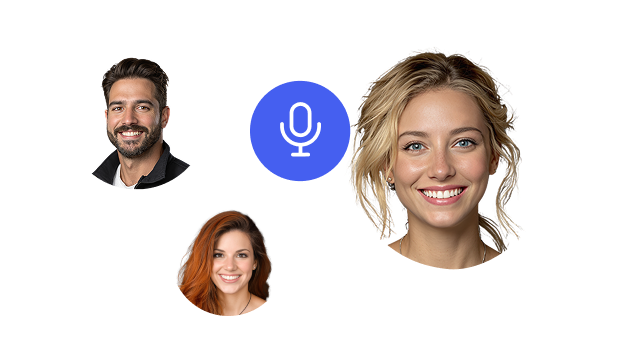How to create a voice over for a podcast—The ultimate guide
Podcasts are at their absolute peak of popularity these days. Everyone is making them, and more importantly, many of us are active podcast listeners. From podcast interviews about true crime to politics and science, there are all sorts of popular podcast formats. Hence, we’ve put together this complete guide for your podcast voice over needs.
Unfortunately, regardless of how good your podcast name or first episode topic is, it won’t matter if the host doesn’t have a good voice. Still, not everyone can have that best podcast voice like an old-school radio anchor or a news presenter.
Luckily for everyone who doesn’t have a podcast-suited voice, there’s an option to use AI narration. Through the use of text to speech apps like Speechify, you don’t have to record scripted intros, prologues, or epilogues. You can use an AI narrator to do it for you.
Why you might need a voice over for your podcast
Let’s face it—not all of us have a great voice. But that’s okay. We don’t have to sound like a professional TV personality to capture someone’s attention if we can make a good first impression, and that’s where voice overs come in to create a consistently high-quality audio portion of your podcast that will instantly hook your target audience.
Still, some parts of every successful podcast or radio show do require a quality voice. One example is voice overs that play over intro music jingles and outros. To prepare them, many podcast hosts and producers use prerecorded voice overs that encapsulate the tone of their show.
How to make sure your audio quality is good enough for a voice over track to be used in your podcast episode
To make your voice over recording good enough, it’s key to use proper podcast equipment. By this, we mean a high-quality microphone, pop filter, and reliable recording software. So, let’s check everything you need, shall we?
- Podcast microphone—You can use a low-end laptop or USB microphone that you use for Skype or Zoom, but that’s not the point. You want to create a voice over that’s worthy of any podcast hosting service, so prepare yourself to splash a couple of dollars more for a good Audio-Technica with an XLR jack in order to record high-quality audio.
- Pop filter—A pop filter, or pop shield, is a netted barrier that goes between your mouth and the microphone. It prevents popping sounds that can make your voice-over sound unprofessional and applicable for monetization. You can find them cheap on Amazon. These are a necessity for making your audio sound smooth and clear.
- Podcast recording and editing software—The best bit about recording a podcast is that you don’t need an expensive audio interface like Adobe Audition. You can even use a freeware app like Audacity or GarageBand (Mac users) and get the desired result, ready for audio editing and mixing. All you need to do is watch a few tutorials and practice.
- Text to speech software—In case you can’t get over your voice, you can always run your script through a text to speech (TTS) app like Speechify and get a perfectly satisfying end product. Speechify offers over 30 natural-sounding AI narrators ready to read aloud any text you come up with.
What to consider when creating your script for the voice over recording session?
The first thing every script requires is a good introduction. The same goes for voice overs for podcasts and radio shows. Your intro should encapsulate what the show is about, establish its tone, and, of course, introduce guests and co-hosts.
All of the above should be conversational. This means that you shouldn’t just list facts about your show like delivery notes. You should instead allow the points to flow through the text, as if the script was a casual conversation with a friend that you’ve just met on the street and not just the bare bones SEO text copy on your podcast website.
While being conversational and introductory, you should also keep a steady pace. Changing the tempo midway through the voice over is a classic beginner’s mistake. You can practice this by running your script through Speechify to hear it back before you say it out loud or to use Speechify’s AI voices for your voice over intro.
Best practices for creating your voice over like a pro
Recording a perfect voice over isn’t easy. This is why there are professional voice actors—people who make a living by recording speeches for various forms of entertainment. Nevertheless, none of them were simply born with a voice over gift. They made their way by practicing and studying various techniques to improve their trade. Therefore, allow us to list some tips on how to improve your voice over technique to attract new listeners:
- Voice acting—Imagine recording a voice over as acting, so play the part of the voice.
- Audio recording clarity—Keep in mind that even the best voice overs can sound bad if the audio file’s sound quality is poor and there’s background noise.
- Pronunciation—Make sure that you’re pronouncing the words of your script correctly. Practicing tongue twisters before recording can help you improve your pronunciation and prevent any accidental slip-ups.
- Pacing—Diction and pacing are essential tools for any narration. If you can keep a steady flow while reading a sentence, you’re halfway there to a perfect voice over.
- Articulation—Make sure not to overdo your character. Over-the-top voices rarely work, especially if your own podcast is looking to send out a serious or heartfelt message.
- Script editing—Don’t be afraid to edit your script over and over again. To listen to how it sounds before you hit the recording studio, try using a text to speech app like Speechify.
FAQ
How do you make a voice for a podcast?
By using text to speech software like Speechify, you can prerecord a whole new episode for your podcast with an artificial narrator. Modern TTS apps offer voices that are so advanced that it can be almost impossible to distinguish them from real human speech. All without a need for complex tutorials.
How do you do a voice over like a pro?
Besides using quality recording equipment, it’s essential to have a good voice. If you’re not satisfied with how you sound, you should work on your diction and even editing skills. You can also rewrite your script and rerecord it until the voice over sounds perfect enough.
How do you do a voice over in Canva?
Tap the “Go to recording studio” option and then allow access to your microphone and camera. In case you have multiple recording devices, choose the desired mic and camera. Afterward, tap the Record button.
How do you write a script for a podcast?
Here are some steps to get started:
- Come up with an introduction.
- Introduce guests if there are any.
- Make sure that your script is conversational.
- Introduce show notes step-by-step.
- Make room for improvisation.
- Be descriptive.
- Maintain a steady pace.
- Always be yourself.
What is the best way to create a voice for a podcast?
Creating a voice template for your new podcast was never as easy as it is with text to speech software. With the likes of Speechify, your podcast will have a narrator worthy of any popular show, sponsorship on social media, or RSS feed of a podcast platform like Spotify, Apple podcasts on iTunes, or Buzzsprout.





